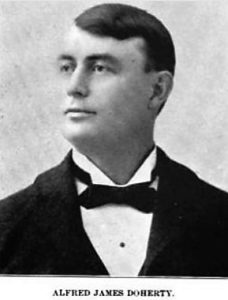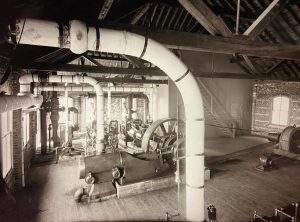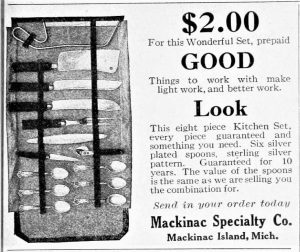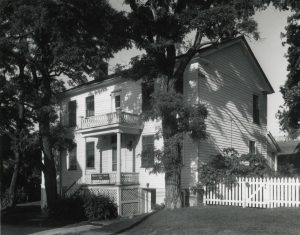“There is a clear suggestion of a Celtic origin in the name that heads this sketch,
and some experiences in the early life of Mr. Doherty show him possessed of a large
percentage of the spirit of independence and self-reliance that is characteristic of the Irish people.”
Men of Progress: Embracing Biographical Sketches of Representative Michigan Men. Detroit (1900)
Alfred James Doherty was born May 1, 1856, in New York City. His grandfather captained an ocean liner, immigrating to America from the north of Ireland. A.J.’s father, Michael, worked as a lumber dealer along New York’s East River, specializing in cutting and marketing ship timbers. The Doherty family eventually settled in western New York state, where they operated a profitable farm and raised many children.
In 1876, Alfred married Alice Gleason, and the young couple set off to make a life in the west. In 1878, they settled in Clare, Michigan, in the midst of the state’s booming lumber industry. Of modest means, A.J. first found employment in a sawmill, working in every department, from piling lumber to scaling logs. Their four children, Floyd, Frank, Lyda, and Alfred Jr., were raised in Clare and would grow up to love Mackinac Island.
With seemingly endless energy, Alfred held many positions over the next decade, including store clerk, teacher, insurance agent, stock farmer, and owner of a hardware store, selling supplies to lumber companies. In 1892, he became general manager of the Clare Woodenware Co., and by 1900 ran the Clare Electric Light Company. He also served as local manager of Michigan Bell Telephone.
Renowned for his “business hustle and ever present smile,” nearly every Michigander would eventually hear of Mr. Doherty. From 1901–1906, “Bellwether Doherty” served three notable terms as State Senator, being a leading member of the Michigan Republican party. He later served on the State Board of Agriculture, the Public Domain Commission, as superintendent of the Michigan State Fair, and as a long-standing trustee of the Michigan State Agricultural College (now Michigan State University).
In 1911, A.J. Doherty became owner of the Municipal Water, Light and Power Company on Mackinac Island. It was a family business, with sons Fred, Frank, and Alfred Jr. each serving various roles for nearly two decades. Originally constructed in 1901, the main building was located along the island’s eastern shore. From there, water was pumped from Lake Huron to a reservoir at Fort Holmes, where gravity-fed pipes distributed it to island locations. In his 1916 report, Names of Places of Interest on Mackinac Island, Michigan, Rev. Frank A. O’Brien boasted, “Mackinac has a fine sewer system, as pure a water supply, and as perfect lighting and electrical service as any place in the country.”
Mackinac Specialty Co.
In 1916, A.J. Doherty combined his boundless energy, agricultural knowledge, and forestry skills in the Mackinac Specialty Company. His signature product was “Mackinac Balsam Balm,” designed for medicinal use. Made from the clear resin of Balsam Fir trees, various balms, decoctions, and tinctures have been made from this fragrant liquid for centuries. Balsam Fir is one of Mackinac Island’s most abundant evergreens, especially common along the shoreline.
Other products, including a “fumigated nest egg” and an eight piece kitchen set, were intended to make life easier on the farm and in the household. With Doherty’s many other business interests, the Mackinac Specialty Company was a short-lived venture, only lasting a few years. Their family legacy, however, would continue to be felt by the Mackinac Island community.
For many years, the Doherty family lived seasonally on Market Street, next to today’s Beaumont Memorial. Now known as the Geary House, the structure was originally built about 1846 by Irish immigrant Matthew Geary, a prominent citizen of 19th century Mackinac Island. Placed on the National Register of Historic Places in 1971, the structure was restored by Mackinac State Historic Parks, but is not open for public tours.
The 1920s were a busy time for the entire family. Alfred Doherty Sr. served a term as mayor of Clare and built the impressive Doherty Hotel, which opened in April 1924. The hotel featured a banquet hall, ballroom, automatic elevator, billiard room, laundry, display rooms for traveling salesman, barber shop, and even a public library. The local paper boasted, “Residents of Clare are free in their assertions that for its size, there is no better hotel in the state.” Nearly 100 years later, the business is still owned by the Doherty family and is a defining feature of the Clare community.
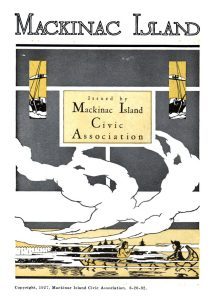 Near the end of the decade, the Dohertys sold their interests in the Municipal Power Company to a New York City firm and brothers Alfred Jr. and Frank helped form the Mackinac Island State Bank. The bank opened October 25, 1928, with Alfred serving as vice president and Frank working as cashier. Frank also became a beloved member of the Mackinac Island Civic Association, a forerunner to the current Chamber of Commerce. The association published an island guide book in 1927, and purchased the large American Fur Company buildings on Market Street in 1930. Frank’s wife, Sarah, served as custodian of the city-owned museum for many years.
Near the end of the decade, the Dohertys sold their interests in the Municipal Power Company to a New York City firm and brothers Alfred Jr. and Frank helped form the Mackinac Island State Bank. The bank opened October 25, 1928, with Alfred serving as vice president and Frank working as cashier. Frank also became a beloved member of the Mackinac Island Civic Association, a forerunner to the current Chamber of Commerce. The association published an island guide book in 1927, and purchased the large American Fur Company buildings on Market Street in 1930. Frank’s wife, Sarah, served as custodian of the city-owned museum for many years.
Senator Alfred J. Doherty died in Clare on September 27, 1929. The following year, Frank B. Doherty passed away, on October 23, 1930, at his home on Mackinac Island. The island community mourned his passing, lowering flags to half-mast as tribute. A special note in his obituary reads, “Mr. Doherty was a genial and attractive personality and popular with all classes. The island surely mourns the death of one who has eagerly and conscientiously promoted the interests and material progress of Mackinac Island.”






